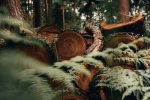Today, we are facing a problem with endangered animals. The list of the species is going on and on. We know that endangered species is a type or group of organisms that are at risk of becoming extinct. The main reason why the species become endangered are due to the loss of habitat from the destruction of the environment and the loss of genetic variation, or there are only a few remaining species that suitable for breeding. Sadly, those reasons are not only happening because of nature but also happen because of human activity.
Endangered animals can happen to any species, including mammals. Until now, there are nearly 450 mammals that have been added into the list of endangered animals. The IUCN Red List includes 44.838 species, where 30 percent of them are at the risk of extinction. How sad is that?
Let’s take a look at some of them that are on the list:
- Finback Whale
Finback whale is the world’s second-biggest living animals. They can grow up to 70 feet in length and 70 tons in weight. They are also known as the greyhound of the sea because of their speed, where despite their massive body, they can travel as fast as 35 miles per hour. You can find them almost in across all of the world’s ocean. Sadly, now we don’t have any exact record about their population outside the North Atlantic but is estimated around 50.000 to 90 individuals. Their population is threatened by the fishing gear, noise pollution that interferes their communication, offshore oil development, and also ship collisions. Most of them happen because of us.
- Wolverine
No, they might look cool and handsome as a superhero in the movie. But their population is under a threat right now due to genetic diversity, global warming that lead to habitat loss, development of resource extraction, roads, and winter recreation in denning areas. Wolverine’s breeding population is estimated at fewer than 50 individual. The number is already low, but the number keeps on decreasing because of global warming. Global warming, which is one of the biggest problems that we’re facing now, impacts their snowpacks, which is important for wolverine to raise their young.
- Sea Otter
How could we let this cutie animal becoming endangered? Sea otter is also known as a smart animal. They know how to use small rocks to open up shellfish as their food. Sea Otters are also important to keep the sea urchin populations under control, so they don’t damage the ecosystem of the kelp forest. We use to see them in the waters off the Pacific coast, but if we let it happen, we might never see them again in the future.
Finback whale, wolverine, and sea otter are only a few examples from thousands of animals listed in the endangered mammals. We don’t want to let them become extinct, right? So here is something that we can do to prevent it happen.
How to Encounter the Problems of Endangered Mammals
1. Tell Everyone
One of the easiest thing that we can do is to tell and educate our friends and family about endangered species, especially mammals in your area. Tell them about wildlife and how every species is matters in our ecosystem. From little tiny worms in our backyard to the birds, squirrels, and more. Tell them that our life is somehow connected and affected many creatures.
2. Sustainable living
It might seem out of context, like how can our trash correlate to orangutan population, for example? Well, the more we buy new things, the more and more resource extraction that we need to produce new goods. If you really have to buy the new one, try to buy more sustainable products. Do you know that palm oil can lead to deforestation, which is one of the reasons for habitat loss for orangutan? Sadly, there are many types of products that still use palm oil, or even made of wood from endangered species. So try to lookup more and be mindful with your purchasing!
It also includes your water consumption and your footprint. We know that clean water is important for us and other living creatures. Be careful to not pollute clean water stream with chemicals. Try to drive less, and walk more or use public transport that is provided. Also, try to eat whole food from the local market instead of processed food. It’s good for your body and also for mother earth!
3. Do not use pesticides or herbicides
Chemicals like pesticides and herbicides are one of the pollutants that can harm wildlife in many aspects. These two might pollute to soils and poison the animals. Remember that many mammals are predators, which are important in the food chain. The poisoned prey might affect the other animals who hunt them, which leads to the whole food chain.
4. Reduce your plastic consumption
Wild animals, especially marine ones, are facing threats from waste in the ocean, where most of them are plastic waste that is not properly managed. Plastic waste that ended up in the ocean being ingested by marine animals including marine mammals who have mistaken them as food. So try to cut down your plastic consumption to produce less plastic waste.
5. Volunteer yourself!
Try to be active with your local community that has a concern on protecting the wildlife. You can start with a small action, like picking up litter at the beach, but together, the impact can be bigger and become massive.
Those are some activities that we can do to encounter the problem of endangered mammals. What we should have in mind that it’s not only mammals that matter. Every species, every aspect of the ecosystem is important too. And the extinction of one species can lead to another problem like a domino. It might also affect our life as a human! Let’s stop the number of the endangered animal list. We cannot lose any species anymore, can we?

